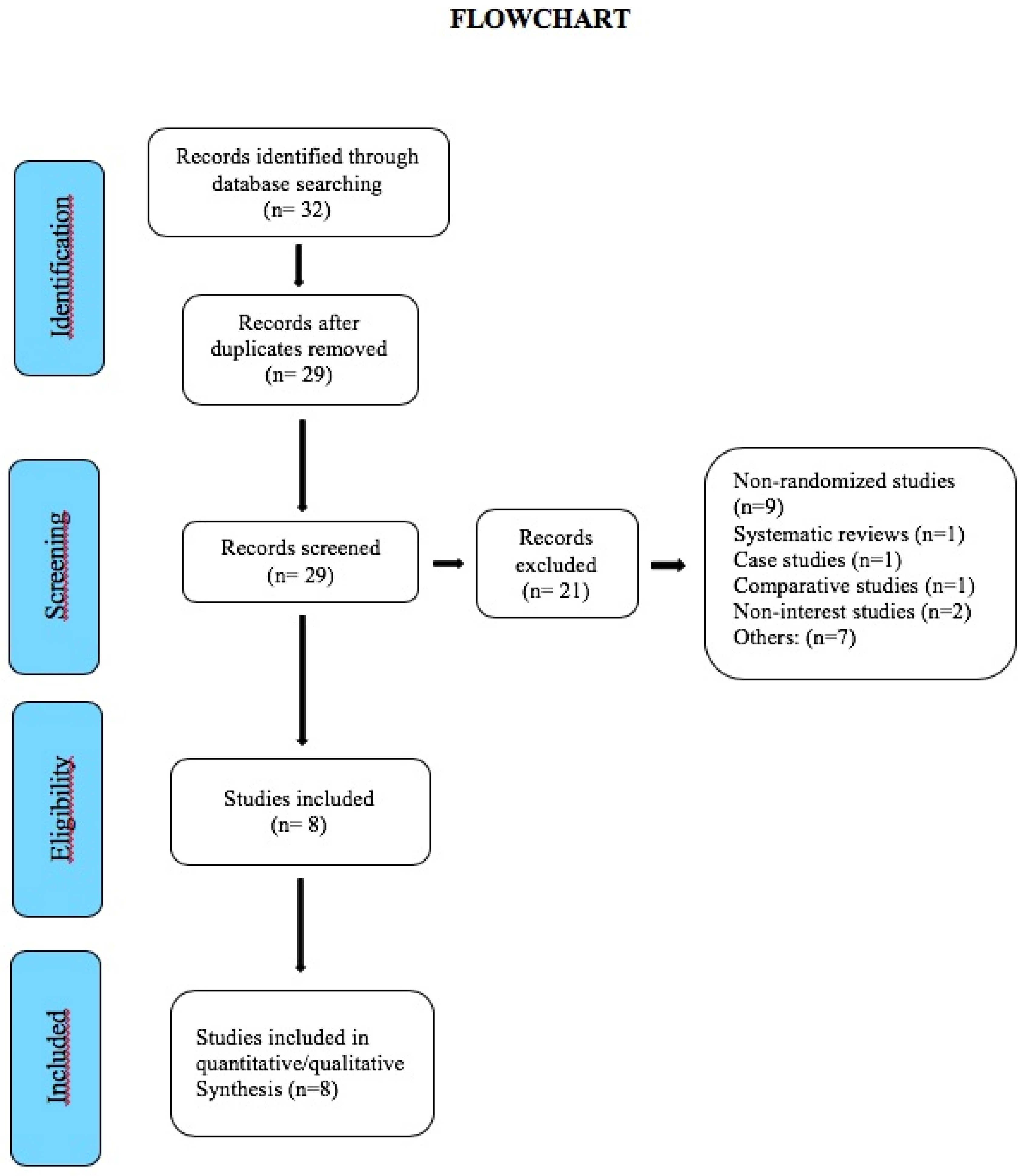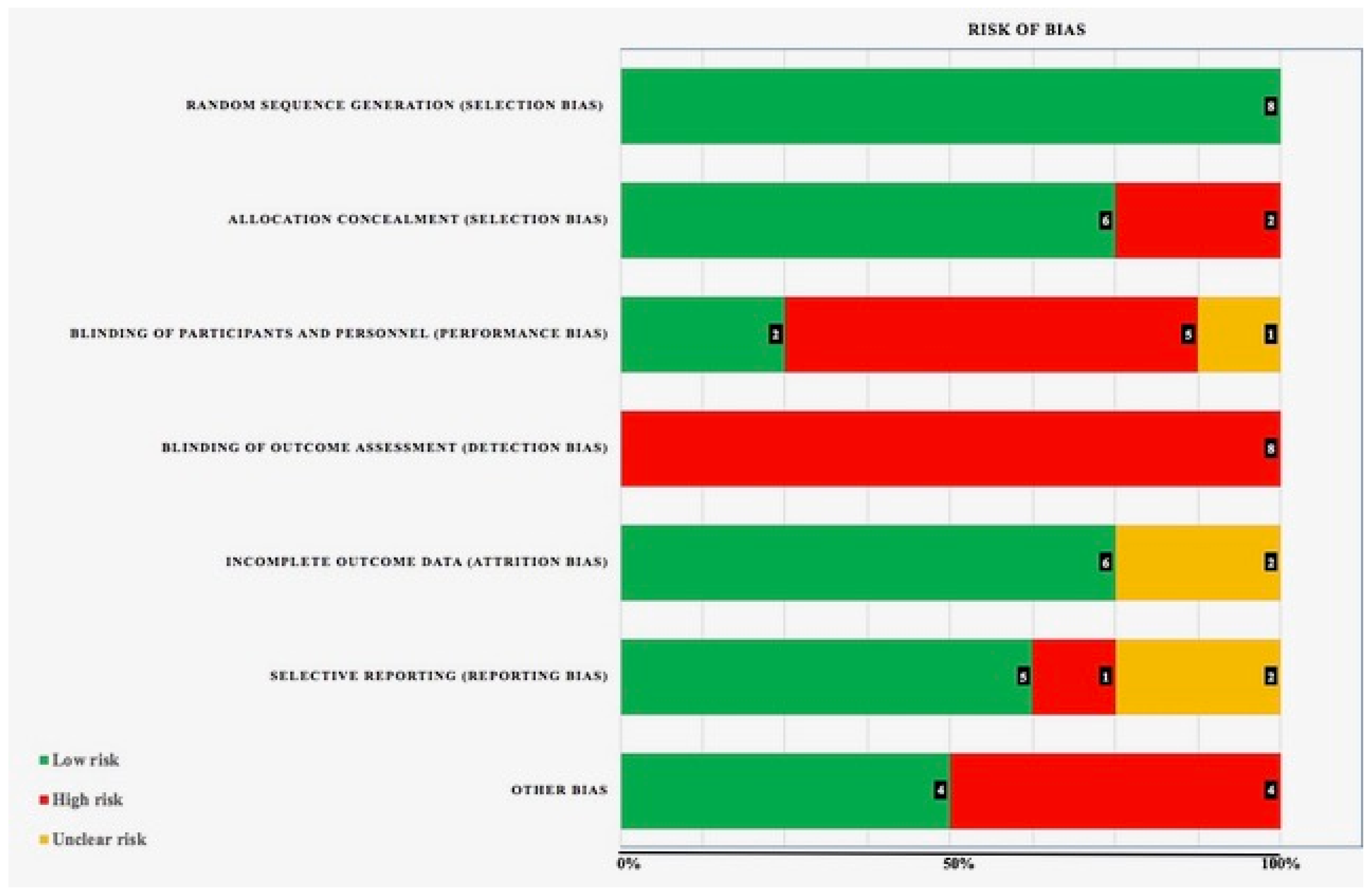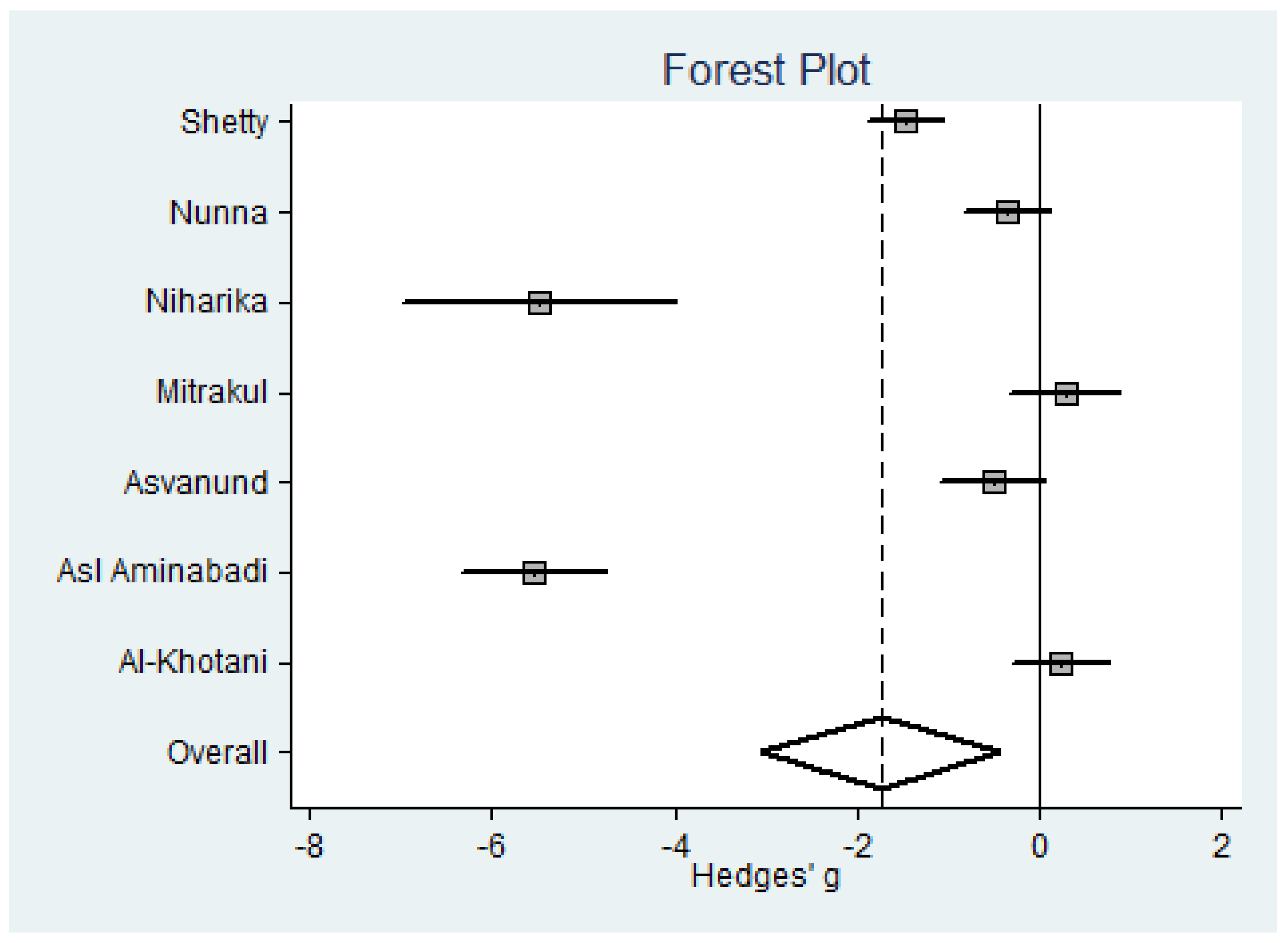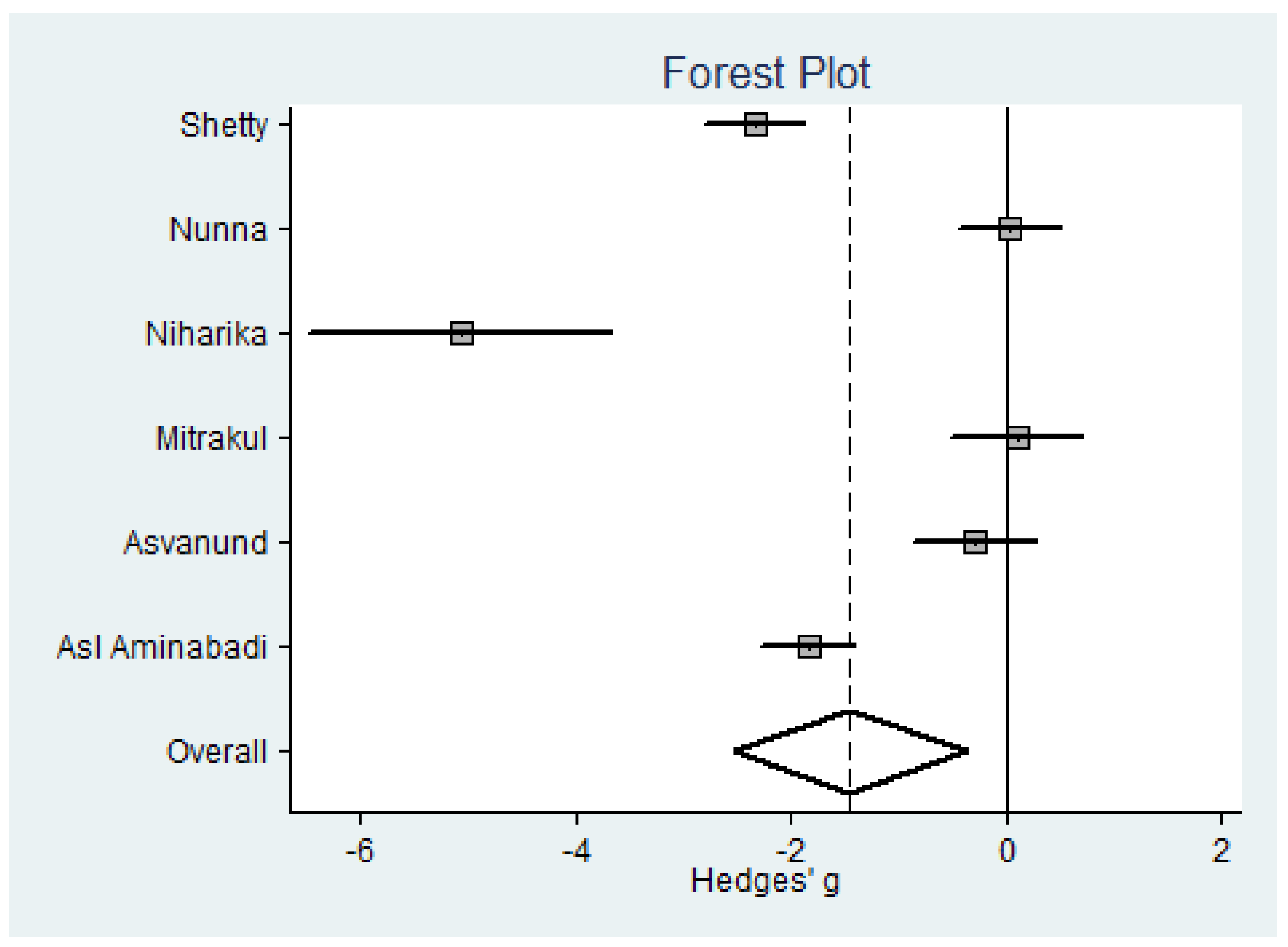Use of Virtual Reality for the Management of Anxiety and Pain in Dental Treatments: Systematic Review and Meta-Analysis
Abstract
1. Introduction
2. Methods
2.1. Protocol
- For pain: Visual Analogic Scale (VAS), Wong–Baker Faces Scale (W–BFS) and Faces Pain Scale-Revised (FPS-R).
- For anxiety: Consolability Scale (FLACC), Verbal Rating Scale (VRS), Modified Dental Anxiety Scale (MDAS), Corah’s Dental Anxiety Scale (CDAS) and Venham’s Clinical Anxiety Rating Scale (VCARS).
2.2. Search Method for the Identification of Studies
2.3. Inclusion and Exclusion Criteria
- (a)
- Articles published in English.
- (b)
- Parallel-arm randomized controlled clinical trials related to dental anxiety and pain associated with dental procedures in children and adults. For crossover clinical trials, only the first period or test-control comparison was considered.
- (c)
- Standard care situations (dental anesthesia, dental extractions, dental fillings, mouth cleanings …)
- (a)
- Non-randomized studies, non-controlled clinical trials or half-mouth design clinical trials.
- (b)
- Comparative studies.
- (c)
- Narrative reviews and systematic reviews.
- (d)
- Case studies.
- (e)
- Irrelevant and duplicate studies and those that did not meet the established inclusion criteria.
2.4. Data Extraction and Analysis
2.5. Risk of Bias (RoB) of Included Articles
2.6. Statistical Analysis
3. Results
3.1. Characteristics of the Studies
3.2. Virtual Reality (VR) and Anxiety Management
3.3. VR and Pain Management
3.4. Publication Bias and Heterogeneity
4. Discussion
5. Conclusions
Author Contributions
Funding
Conflicts of Interest
Abbreviations
| VR | Virtual Reality |
| DA | Dental Anxiety |
| VAS | Visual Analogic Scale |
| W–BFS | Wong–Baker Faces Scale |
| FPS-R | Faces Pain Scale-Revise |
| FLACC | Consolability Scale |
| VRS | Verbal Rating Scale |
| MDAS | Modified Dental Anxiety Scale |
| CDAS | Corah’s Dental Anxiety Scale |
| VCARS | Venham’s Clinical Anxiety Rating Scale |
| RoB | Risk of Bias |
| SDs | Standard Deviation |
| SMD | Standard Mean Deviation |
| CI | Confidence Interval |
References
- López-Valverde, A.; Montero, J.; Albaladejo, A.; Gómez de Diego, R. The discovery of surgical anesthesia: Discrepancies regarding its authorship. J. Dent. Res. 2011, 90, 31–34. [Google Scholar] [CrossRef] [PubMed]
- Weisenberg, M.; Aviram, O.; Wolf, Y.; Raphaeli, N. Relevant and irrelevant anxiety in the reaction to pain. Pain 1984, 20, 371–383. [Google Scholar] [CrossRef]
- Al Absi, M.; Rokke, P.D. Can anxiety help us tolerate pain? Pain 1991, 46, 43–51. [Google Scholar] [CrossRef]
- US National Library of Medicine. Available online: https://www.nlm.nih.gov (accessed on 2 November 2019).
- Ougradar, A.; Ahmed, B. Patients’ perceptions of the benefits of virtual reality during dental extractions. Br. Dent. J. 2019, 227, 813–816. [Google Scholar] [CrossRef]
- Carl, E.; Stein, A.T.; Levihn-Coon, A.; Pogue, J.R.; Rothbaum, B.; Emmelkamp, P.; Asmundson, G.; Carlbring, P.; Powers, M.B. Virtual reality exposure therapy for anxiety and related disorders: A meta-analysis of randomized controlled trials. J. Anxiety Disord. 2019, 61, 27–36. [Google Scholar] [CrossRef]
- Eijlers, R.; Utens, E.; Staals, L.M.; de Nijs, P.F.A.; Berghmans, J.M.; Wijnen, R.M.H.; Hillegers, M.H.J.; Dierckx, B.; Legerstee, J.S. Systematic Review and Meta-analysis of Virtual Reality in Pediatrics: Effects on Pain and Anxiety. Anesth. Analg. 2019, 129, 1344–1353. [Google Scholar] [CrossRef]
- Gujjar, K.R.; van Wijk, A.; Kumar, R.; de Jongh, A. Efficacy of virtual reality exposure therapy for the treatment of dental phobia in adults: A randomized controlled trial. J. Anxiety Disord. 2019, 62, 100–108. [Google Scholar] [CrossRef]
- Raghav, K.; Van Wijk, A.J.; Abdullah, F.; Islam, M.N.; Bernatchez, M.; De Jongh, A. Efficacy of virtual reality exposure therapy for treatment of dental phobia: A randomized control trial. BMC Oral Health 2016, 27, 25. [Google Scholar] [CrossRef]
- Wiederhold, M.D.; Gao, K.; Wiederhold, B.K. Clinical use of virtual reality distraction system to reduce anxiety and pain in dental procedures. Cyberpsychol. Behav. Soc. Netw. 2014, 17, 359–365. [Google Scholar] [CrossRef]
- Tanja-Dijkstra, K.; Pahl, S.; White, M.P.; Andrade, J.; Qian, C.; Bruce, M.; May, J.; Moles, D.R. Improving dental experiences by using virtual reality distraction: A simulation study. PLoS ONE 2014, 2, e91276. [Google Scholar] [CrossRef]
- Dahlquist, L.M.; McKenna, K.D.; Jones, K.K.; Dillinger, L.; Weiss, K.E.; Ackerman, C.S. Active and passive distraction using a head-mounted display helmet: Effects on cold pressor pain in children. Health Psychol. 2014, 26, 794–801. [Google Scholar] [CrossRef] [PubMed]
- Schneider, S.M.; Hood, L.E. Virtual reality: A distraction intervention for chemotherapy. Oncol. Nurs. Forum 2007, 34, 39–46. [Google Scholar] [CrossRef] [PubMed]
- Malloy, K.M.; Milling, L.S. The effectiveness of virtual reality distraction for pain reduction: A systematic review. Clin. Psychol. Rev. 2010, 30, 1011–1018. [Google Scholar] [CrossRef] [PubMed]
- American Society of Anesthesiologists Task Force on Sedation and Analgesia by Non-Anesthesiologists. Practice guidelines for sedation and analgesia by non-anesthesiologists. Anesthesiology 2002, 96, 1004–1017. [Google Scholar] [CrossRef]
- Dixon, R.A.; Kenyon, C.; Marsh, D.R.; Thornton, J.A. Midazolam in conservative dentistry. A cross-over trial. Anaesthesia 1986, 41, 276–281. [Google Scholar] [CrossRef]
- Foley, J. The way forward for dental sedation and primary cares? Br. Dent. J. 2002, 193, 161–164. [Google Scholar] [CrossRef]
- Hutton, B.; Ferrán Catalá-López, F.; Moher, D. The PRISMA statement extension for systematic reviews incorporating network meta-analysis: PRISMA-NMA. Med. Clin. 2016, 16, 262–266. [Google Scholar] [CrossRef]
- Higgins, J.P.T.; Altman, D.G.; Sterne, J.A.C. Cochrane Handbook for Systematic Reviews of Interventions; Version, 5.1.0; Higgins, J.P.T., Green, S., Eds.; The Cochrane Collaboration: London, UK, 2006; Chapter 8; Available online: http://www.cochrane-handbook.org (accessed on 20 October 2019).
- Tanja-Dijkstra, K.; Pahl, S.; White, M.P.; Andrade, J.; May, J.; Stone, R.J.; Bruce, M.; Mills, I.; Auvray, M.; Gabe, R.; et al. Can virtual nature improve patient experiences and memories of dental treatment? A study protocol for a randomized controlled trial. Trials 2014, 22, 90. [Google Scholar] [CrossRef]
- Furman, E.; Jasinevicius, R.; Bissada, N.F.; Victoroff, K.Z.; Skillicorn, R.; Buchner, M. Virtual reality distraction for pain control during periodontal scaling and root planing procedures. J. Am. Dent. Assoc. 2019, 140, 1508–1516. [Google Scholar] [CrossRef]
- Bentsen, B.; Svensson, P.; Wenzel, A. Evaluation of effect of 3D video glasses on perceived pain and unpleasantness induced by restorative dental treatment. Eur. J. Pain 2001, 5, 373–378. [Google Scholar] [CrossRef]
- Al-Halabi, M.N.; Bshara, N.; AlNerabieah, Z. Effectiveness of audio-visual distraction using virtual reality eyeglasses versus tablet device in child behavioral management during inferior alveolar nerve block. Anaesth. Pain Intensive Care 2018, 22, 55–61. [Google Scholar]
- Niharika, P.; Reddy, N.V.; Srujana, P.; Srikanth, K.; Daneswari, V.; Geetha, K.S. Effects of distraction using virtual reality technology on pain perception and anxiety levels in children during pulp therapy of primary molars. J. Indian Soc. Pedod. Prev. Dent. 2018, 36, 364–369. [Google Scholar] [CrossRef] [PubMed]
- Asl Aminabadi, N.; Erfanparast, L.; Sohrabi, A.; Ghertasi Oskouei, S.; Naghili, A. The Impact of Virtual Reality Distraction on Pain and Anxiety during Dental Treatment in 4-6 Year-Old Children: A Randomized Controlled Clinical Trial. J. Dent. Res. Dent. Clin. Dent. Prospect. 2012, 6, 117–124. [Google Scholar]
- Nunna, M.; Dasaraju, R.K.; Kamatham, R.; Mallineni, S.K.; Nuvvula, S. Comparative evaluation of virtual reality distraction and counter-stimulation on dental anxiety and pain perception in children. J. Dent. Anesth. Pain Med. 2019, 19, 277–288. [Google Scholar] [CrossRef] [PubMed]
- Shetty, V.; Suresh, L.R.; Hegde, A.M. Effect of Virtual Reality Distraction on Pain and Anxiety during Dental Treatment in 5 to 8 Year Old Children. J. Clin. Pediatr. Dent. 2019, 43, 97–102. [Google Scholar] [CrossRef] [PubMed]
- Al-Khotani, A.; Bello, L.A.; Christidis, N. Effects of audiovisual distraction on children’s behaviour during dental treatment: A randomized controlled clinical trial. Acta Odontol. Scand. 2016, 74, 494–501. [Google Scholar] [CrossRef]
- Mitrakul, K.; Asvanund, Y.; Arunakul, M.; Paka-Akekaphat, S. Effect of audiovisual eyeglasses during dental treatment in 5–8 year-old children. Eur. J. Paediatr. Dent. 2015, 16, 239–245. [Google Scholar]
- Asvanund, Y.; Mitrakul, K.; Juhong, R.O.; Arunakul, M. Effect of audiovisual eyeglasses during local anesthesia injections in 5- to 8-year-old children. Quintessence Int. 2015, 46, 513–521. [Google Scholar]
- Sweta, V.R.; Abhinav, R.P.; Asha, R. Role of Virtual Reality in Pain Perception of Patients Following the Administration of Local Anesthesia. Ann. Maxillofac. Surg. 2019, 9, 110–113. [Google Scholar] [PubMed]
- Cohen, J. Statistical Power Analysis for the Behavioral Sciences, 2nd ed.; Lawrence Erlbaum Associates: New York, NY, USA, 1988. [Google Scholar]
- Yamashita, Y.; Shimohira, D.; Aijima, R.; Mori, K.; Danjo, A. Clinical Effect of Virtual Reality to Relieve Anxiety During Impacted Mandibular Third Molar Extraction Under Local Anesthesia. J. Oral Maxillofac. Surg. 2019, 26, 31343–31346. [Google Scholar] [CrossRef]
- Hill, K.B.; Chadwick, B.; Freeman, R.; O’Sullivan, I.; Murray, J.J. Adult Dental Health Survey 2009: Relationships between dental attendance patterns, oral health behaviour and the current barriers to dental care. Br. Dent. J. 2013, 214, 25–32. [Google Scholar] [CrossRef]
- Seligman, L.D.; Hovey, J.D.; Chacon, K.; Ollendick, T.H. Dental anxiety: An understudied problem in youth. Clin. Psychol. Rev. 2017, 55, 25–40. [Google Scholar] [CrossRef] [PubMed]
- De Stefano, R. Psychological Factors in Dental Patient Care: Odontophobia. Medicina 2019, 8, 678. [Google Scholar] [CrossRef] [PubMed]
- Fiorillo, L. Oral Health: The First Step to Well-Being. Medicina 2019, 7, 676. [Google Scholar] [CrossRef]
- Bolton, D.; Dearsley, P.; Madronal-Luque, R.; Baron-Cohen, S. Magical thinking in childhood and adolescence: Development and relation to obsessive compulsion. Br. J. Dev. Psychol. 2002, 20, 479–494. [Google Scholar] [CrossRef]
- Thompson, S.G.; Higgins, J.P. How should meta-regression analyses be undertaken and interpreted? Stat. Med. 2002, 21, 559–573. [Google Scholar] [CrossRef]
- Klassen, J.A.; Liang, Y.; Tjosvold, L.; Klassen, T.P.; Hartling, L. Music for pain and anxiety in children undergoing medical procedures: A systematic review of randomized controlled trials. Ambul. Pediatr. 2008, 8, 117–128. [Google Scholar] [CrossRef]
- Uman, L.S.; Chambers, C.T.; McGrath, P.J.; Kisely, S. Psychological interventions for needle-related procedural pain and distress in children and adolescents. Cochrane Database Syst. Rev. 2006, 18, CD005179. [Google Scholar]
- Uman, L.S.; Birnie, K.A.; Noel, M.; Parker, J.A.; Chambers, C.T.; McGrath, P.J.; Kisely, S.R. Psychological interventions for needle-related procedural pain and distress in children and adolescents. Cochrane Database Syst. Rev. 2013, 10, CD005179. [Google Scholar] [CrossRef]
- Birnie, K.A.; Noel, M.; Chambers, C.T.; Uman, L.S.; Parker, J.A. Psychological interventions for needle-related procedural pain and distress in children and adolescents. Cochrane Database Syst. Rev. 2018, 10, 842–854. [Google Scholar] [CrossRef] [PubMed]
- Hoffman, H.G.; Sharar, S.R.; Coda, B.; Everett, J.J.; Ciol, M.; Richards, T.; Patterson, D.R. Manipulating presence influences the magnitude of virtual reality analgesia. Pain 2004, 111, 162–168. [Google Scholar] [CrossRef] [PubMed]
- Yu, M.; Zhou, R.; Wang, H.; Zhao, W. An evaluation for VR glasses system user experience: The influence factors of interactive operation and motion sickness. Appl. Ergon. 2019, 74, 206–213. [Google Scholar] [CrossRef] [PubMed]
- Basudan, S.; Binanzan, N.; Alhassan, A. Depression, anxiety and stress in dental students. Int. J. Med. Educ. 2017, 8, 179–186. [Google Scholar] [CrossRef] [PubMed]
- Thomson, W.; Broadbent, J.M.; Locker, D.; Poulton, R. Trajectories of dental anxiety in a birth cohort. Community Dent. Oral Epidemiol. 2009, 37, 209–219. [Google Scholar] [CrossRef] [PubMed]
- Jain, A.; Suprabha, B.S.; Shenoy, R.; Rao, A. Association of temperament with dental anxiety and behaviour of the preschool child during the initial dental visit. Eur. J. Oral Sci. 2019, 127, 147–155. [Google Scholar] [CrossRef] [PubMed]
- Bergdahl, M.; Bergdahl, J. Temperament and character personality dimensions in patients with dental anxiety. Eur. J. Oral. Sci. 2003, 111, 93–98. [Google Scholar] [CrossRef] [PubMed]
- Stenebrand, A.; Wide Boman, U.; Hakeberg, M. Dental anxiety and temperament in 15-year olds. Acta Odontol. Scand. 2013, 71, 15–21. [Google Scholar] [CrossRef]
- Lundgren, J.; Elfström, M.L.; Berggren, U. The relationship between temperament and fearfulness in adult dental phobic patients. Int. J. Paediatr. Dent. 2007, 17, 460–468. [Google Scholar] [CrossRef]
- Klages, U.; Kianifard, S.; Ulusoy, O.; Wehrbein, H. Anxiety sensitivity as predictor of pain in patients undergoing restorative dentalprocedures. Commun. Dent. Oral Epidemiol. 2006, 34, 139–145. [Google Scholar] [CrossRef]
- Lin, C.S.; Wu, S.Y.; Yi, C.A. Association between Anxiety and Pain in Dental Treatment: A Systematic Review and Meta-analysis. J. Dent. Res. 2017, 96, 153–162. [Google Scholar] [CrossRef]
- Astramskaitė, I.; Juodžbalys, G. Scales used to rate adult patients’ psycho-emotional status in tooth extraction procedures: A systematic review. Int. J. Oral Maxillofac. Surg. 2017, 46, 886–898. [Google Scholar] [CrossRef] [PubMed]
- Eijlers, R.; Legerstee, J.S.; Dierckx, B.; Staals, L.M.; Berghmans, J.; van der Schroeff, M.P.; Wijnen, R.M.; Utens, E.M. Development of a Virtual Reality Exposure Tool as Psychological Preparation for Elective Pediatric Day Care Surgery: Methodological Approach for a Randomized Controlled Trial. JMIR Res. Protoc. 2017, 6, e174. [Google Scholar] [CrossRef] [PubMed]




| Study (Year) | Journal | Children Values (Ma, n, Ar) | Adult Values (Ma, n, Ar) | Dental Procedure | Virtual Reality (VR) Device Equipment | Measuring Scales | Outcomes | |
|---|---|---|---|---|---|---|---|---|
| DA | p | |||||||
| Niharika et al. 2018 [24] | J Indian Soc Pedod Prev Dent | Ma = Group A (7.17 ± 0.316) Group B (7.28 ± 0.300) n = 40 Ar = 4–8 | Routine dental care (pulp therapy in mandibular primary molars). Local anesthetic. | Google VR Box and Anti-Tank Virtual Reality 3D Glasses | MDAS | W-BFS | Two groups. Childhood Anxiety-Related Disorders scores did not differ significantly between the two groups. In both groups, a statistically significant difference was detected between the two treatment sessions (with and without VR). | |
| Asl Aminabadi et al. 2012 [25] | J Dent Res Dent Clin Dent Prospect | Ma = 5.4 n = 120 Ar = 4–6 | Restorative treatment in primary molars. | I-glasses 920HR Ilixco, Inc. Menlo Park, CA, USA. | MDAS | W-BFS | There was a significant decrease in pain perception and anxiety scores with the use of VR eyeglasses during dental treatment. | |
| Nunna et al. 2019 [26] | J Dent Anesth Pain Med | Ma = Nr n = 70 Ar = 7–11 | - Counter-stimulation. - Local anesthesia administration with virtual reality distraction. | Lenovo smartphone, Sennheiser earphones, and ANTVR glasses. | VCARS | W-BFS | Assessment of mean anxiety scores showed a significant difference in girls belonging to the VR group. | |
| Shetty et al. 2019 [27] | The Journal of Clinical Paediatric Dentistry | Ma = Nr n = 120 Ar = 5–8 | Dental treatment (vital pulp therapy) | Eyeglasses. VR device (i-glasses 920HR, Ilixco Inc., Menlo Park, CA, USA) | MDAS | W-BFS | Two groups. The group where VR distraction was used reported a decrease in the severity of anxiety. Lower pain scores were observed in the VR group. | |
| Al-Khotani et al. 2016 [28] | Acta Odontologica Scandinavica | Ma = 8.2 n = 56 Ar = 7–9 | Dental examination, oral hygiene information, prophylaxis, restorative treatment. | Eyeglasses. DVD Players, gaming systems like Sony Play Station Pro, Microsoft X-BOX, Nintendo WII | MDAS | Two groups. VR and control group. Significant reduction in anxiety throughout the restorative procedure (including injection with local anesthesia) in VR group. | ||
| Mitrakul et al. 2015 [29] | European Journal of Paediatric Dentistry | Ma = 6.9 ± 0.9 n = 42 Ar = 5–8 | Restorative dental treatment in maxilla or mandible under local anesthetic injection. | Eyeglasses. (Shenzhen Longway Vision Technology Co. Ltd., Shenzhen, China). | FLACC | FPS-R | Two groups. Group 1 received treatment without wearing VR during the first visit and wearing VR during a second visit. In Group 2, VR was used viceversa. | |
| Asvanund et al. 2015 [30] | Quintessence International | Ma = 7 ± 0.8 n = 49 Ar = 5–8 | Restorative dental treatment (local anesthetic injection in the maxillary arch or mandibular block). | Eyeglasses (Shenzhen Longway Vision Technology Co. Ltd., Shenzhen, China). | FLACC | FPS-R | Two groups. The study assesses pain and anxiety without distinction. The limitation of this study is that the FLACC score was assessed by playing back the video recording of each visit, which was done by two pediatric dentists who could not be blinded to the child’s use of VR. | |
| Sweta et al. 2019 [31] | Ann Maxillofac Surgery | Ma = 39.72 ± 15.93. n = 50 Ar = Nr | Local anesthesia in patients undergoing a dental procedure. | Nr | CDAS | Local anesthesia and extractions reported the highest anxiety levels among the patients. Limitations of this study: - Small sample size. - Patients were not in control of their VR environment. | ||
| Test | Control | SMD a | Heterogeneity I2 (p-Value) | Public. Bias p-Value (Egger Test) | ||||||||
|---|---|---|---|---|---|---|---|---|---|---|---|---|
| Age group/Study | Year | Scale | n | mean ± sd | n | mean ± sd | Weight | Mean | 95% CI | p-value | ||
| Anxiety (n = 7) (see Figure 3) | ||||||||||||
| Shetty [27] | 2019 | MDAS | 60 | 11.3 ± 3.5 | 60 | 16.5 ± 3.5 | 14.8% | −1.48 | −1.88 to −1.07 | |||
| Nunna [26] | 2019 | VCARS | 35 | 0.57 ± 0.61 | 35 | 0.8 ± 0.7 | 14.7% | −0.35 | −0.83 to 0.12 | |||
| Niharika [24] b | 2018 | MDAS | 18 | 14.7 ± 0.8 | 18 | 19.6 ± 0.9 | 12.6% | −5.48 | −6.97 to −3.99 | |||
| Mitrakul [29] b | 2015 | FLACC | 21 | 0.95 ± 1.63 | 21 | 0.57 ± 0.98 | 14.5% | 0.28 | −0.33 to 0.89 | |||
| Asvanund [30] b | 2015 | FLACC | 26 | 1.65 ± 2.04 | 23 | 2.7 ± 2.0 | 14.6% | −0.51 | −1.08 to 0.06 | |||
| Asl Aminabadi [25] b | 2012 | MDAS | 60 | 12.6 ± 1.0 | 60 | 18.2 ± 1.0 | 14.2% | −5.55 | −6.35 to −4.75 | |||
| Al-Khotani [28] | 2016 | MDAS | 28 | 1.93 ± 1.15 | 28 | 1.68 ± 0.86 | 14.6% | 0.24 | −0.28 to 0.77 | |||
| Total | 248 | 245 | 100% | −1.75 | −3.06 to −0.43 | 0.009 | 51% (p = 0.058) | p = 0.197 | ||||
| Pain (n = 6) (see Figure 4) | ||||||||||||
| Shetty [27] | 2019 | W-BFS | 60 | 2.42 ± 1.47 | 60 | 5.60 ± 1.22 | 17.4% | −2.34 | −2.81 to −1.87 | |||
| Nunna [26] | 2019 | W-BFS | 35 | 3.03 ± 2.02 | 35 | 2.97 ± 2.49 | 17.3% | 0.03 | −0.44 to 0.49 | |||
| Niharika [24] b | 2018 | W-BFS | 18 | 2.56 ± 0.39 | 18 | 5.44 ± 0.68 | 13.8% | −5.07 | −6.47 to −3.67 | |||
| Mitrakul [29] b | 2015 | FPS-R | 21 | 1.90 ± 2.93 | 21 | 1.62 ± 2.94 | 17.0% | 0.09 | −0.51 to 0.7 | |||
| Asvanund [30] b | 2015 | FPS-R | 26 | 2.23 ± 2.29 | 23 | 3.04 ± 3.08 | 17.1% | −0.30 | −0.86 to 0.27 | |||
| Asl Aminabadi [25] b | 2012 | W-BFS | 60 | 1.89 ± 0.65 | 60 | 3.05 ± 0.60 | 17.4% | −1.84 | −2.27 to −1.41 | |||
| Total | 220 | 217 | 100% | −1.46 | −2.54 to −0.37 | 0.008 | 49% (p = 0.082) | p = 0.617 | ||||
© 2020 by the authors. Licensee MDPI, Basel, Switzerland. This article is an open access article distributed under the terms and conditions of the Creative Commons Attribution (CC BY) license (http://creativecommons.org/licenses/by/4.0/).
Share and Cite
López-Valverde, N.; Muriel-Fernández, J.; López-Valverde, A.; Valero-Juan, L.F.; Ramírez, J.M.; Flores-Fraile, J.; Herrero-Payo, J.; Blanco-Antona, L.A.; Macedo-de-Sousa, B.; Bravo, M. Use of Virtual Reality for the Management of Anxiety and Pain in Dental Treatments: Systematic Review and Meta-Analysis. J. Clin. Med. 2020, 9, 3086. https://doi.org/10.3390/jcm9103086
López-Valverde N, Muriel-Fernández J, López-Valverde A, Valero-Juan LF, Ramírez JM, Flores-Fraile J, Herrero-Payo J, Blanco-Antona LA, Macedo-de-Sousa B, Bravo M. Use of Virtual Reality for the Management of Anxiety and Pain in Dental Treatments: Systematic Review and Meta-Analysis. Journal of Clinical Medicine. 2020; 9(10):3086. https://doi.org/10.3390/jcm9103086
Chicago/Turabian StyleLópez-Valverde, Nansi, Jorge Muriel-Fernández, Antonio López-Valverde, Luis Francisco Valero-Juan, Juan Manuel Ramírez, Javier Flores-Fraile, Julio Herrero-Payo, Leticia Alejandra Blanco-Antona, Bruno Macedo-de-Sousa, and Manuel Bravo. 2020. "Use of Virtual Reality for the Management of Anxiety and Pain in Dental Treatments: Systematic Review and Meta-Analysis" Journal of Clinical Medicine 9, no. 10: 3086. https://doi.org/10.3390/jcm9103086
APA StyleLópez-Valverde, N., Muriel-Fernández, J., López-Valverde, A., Valero-Juan, L. F., Ramírez, J. M., Flores-Fraile, J., Herrero-Payo, J., Blanco-Antona, L. A., Macedo-de-Sousa, B., & Bravo, M. (2020). Use of Virtual Reality for the Management of Anxiety and Pain in Dental Treatments: Systematic Review and Meta-Analysis. Journal of Clinical Medicine, 9(10), 3086. https://doi.org/10.3390/jcm9103086







